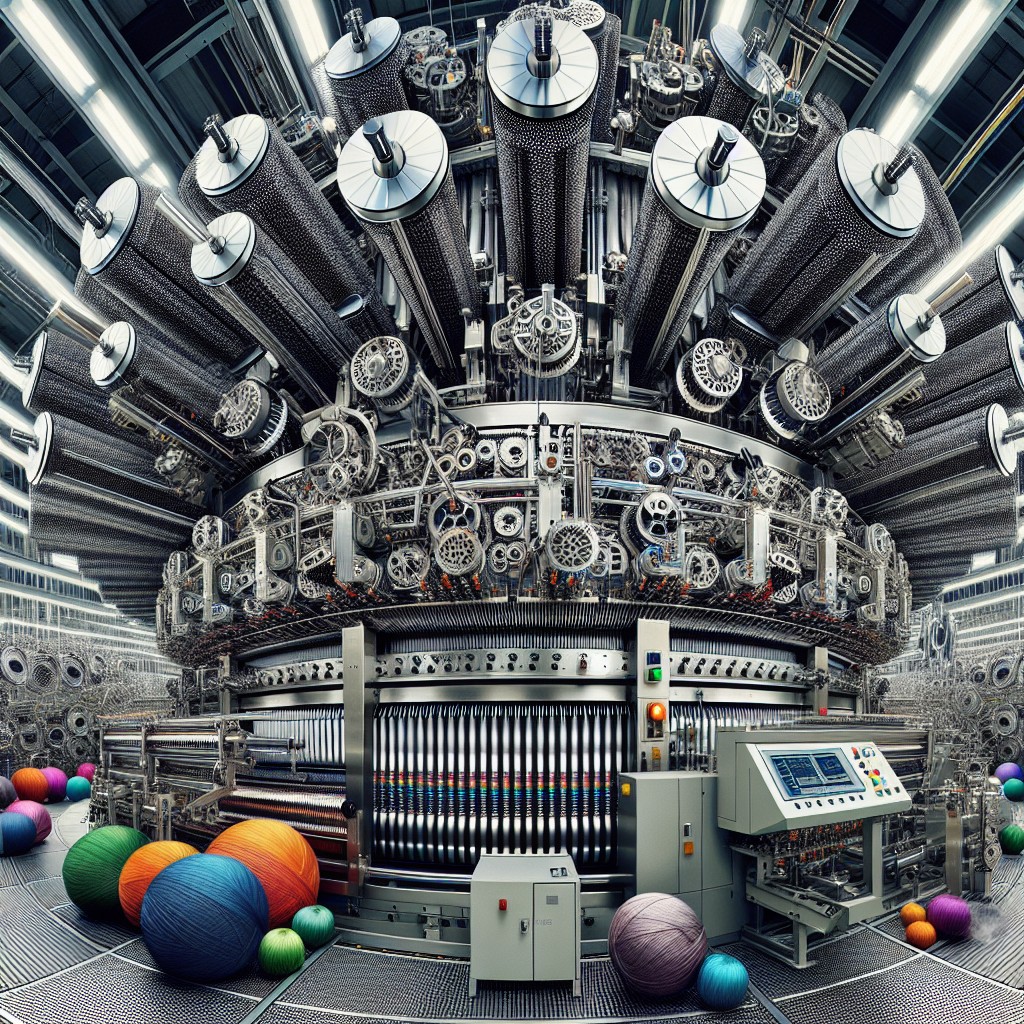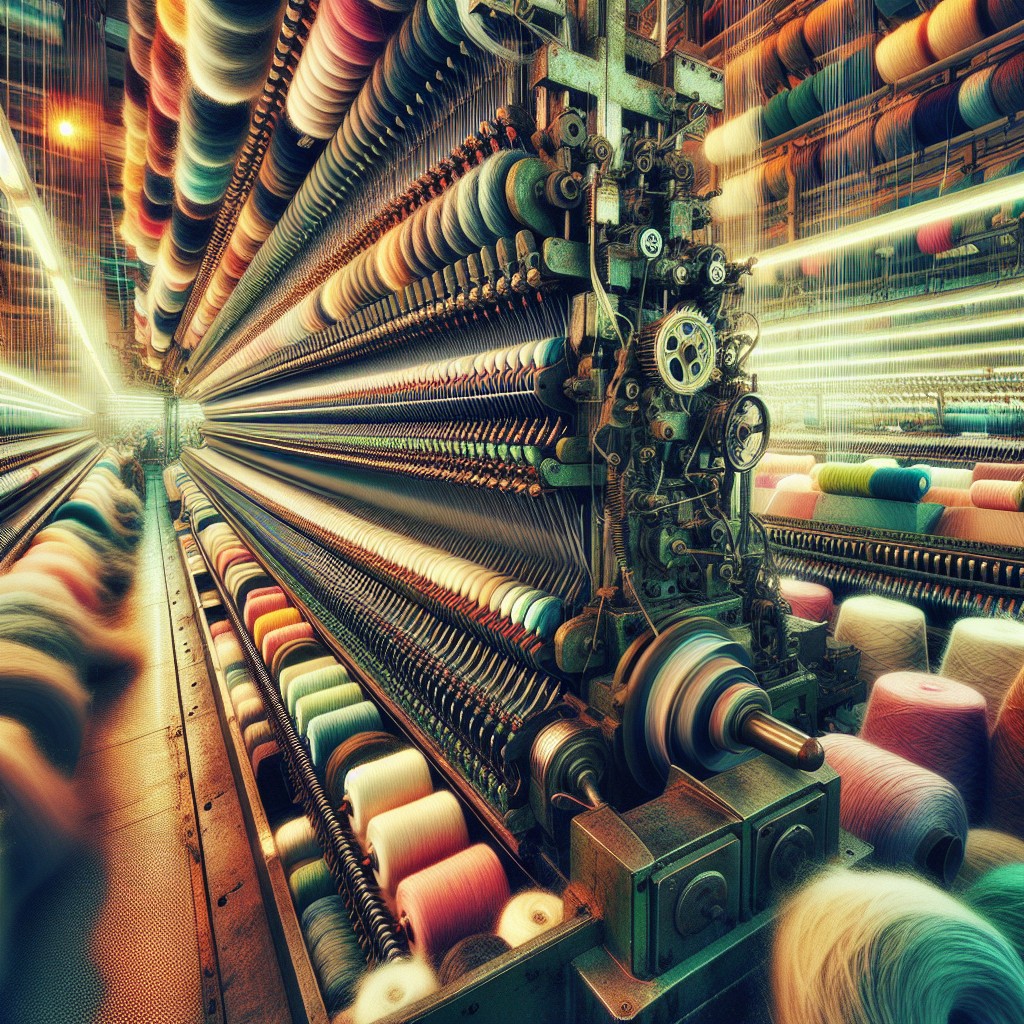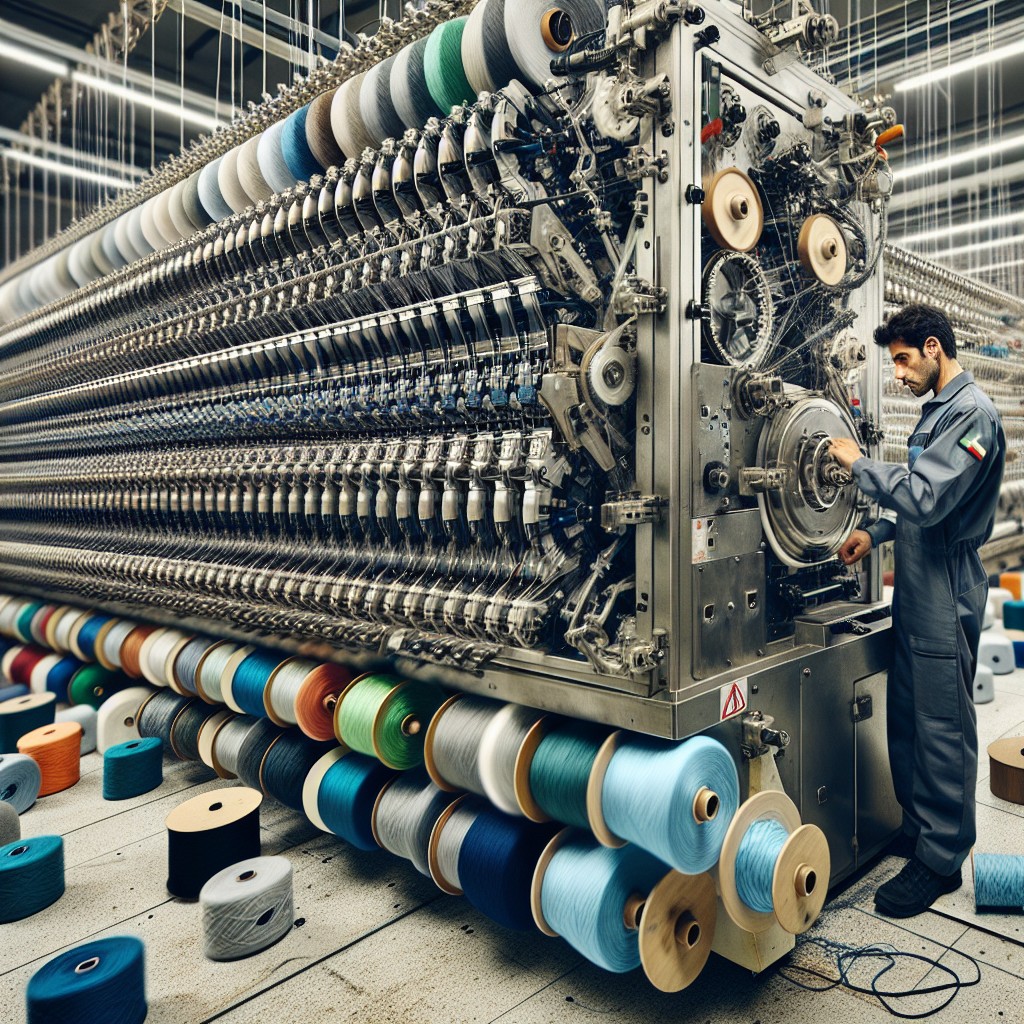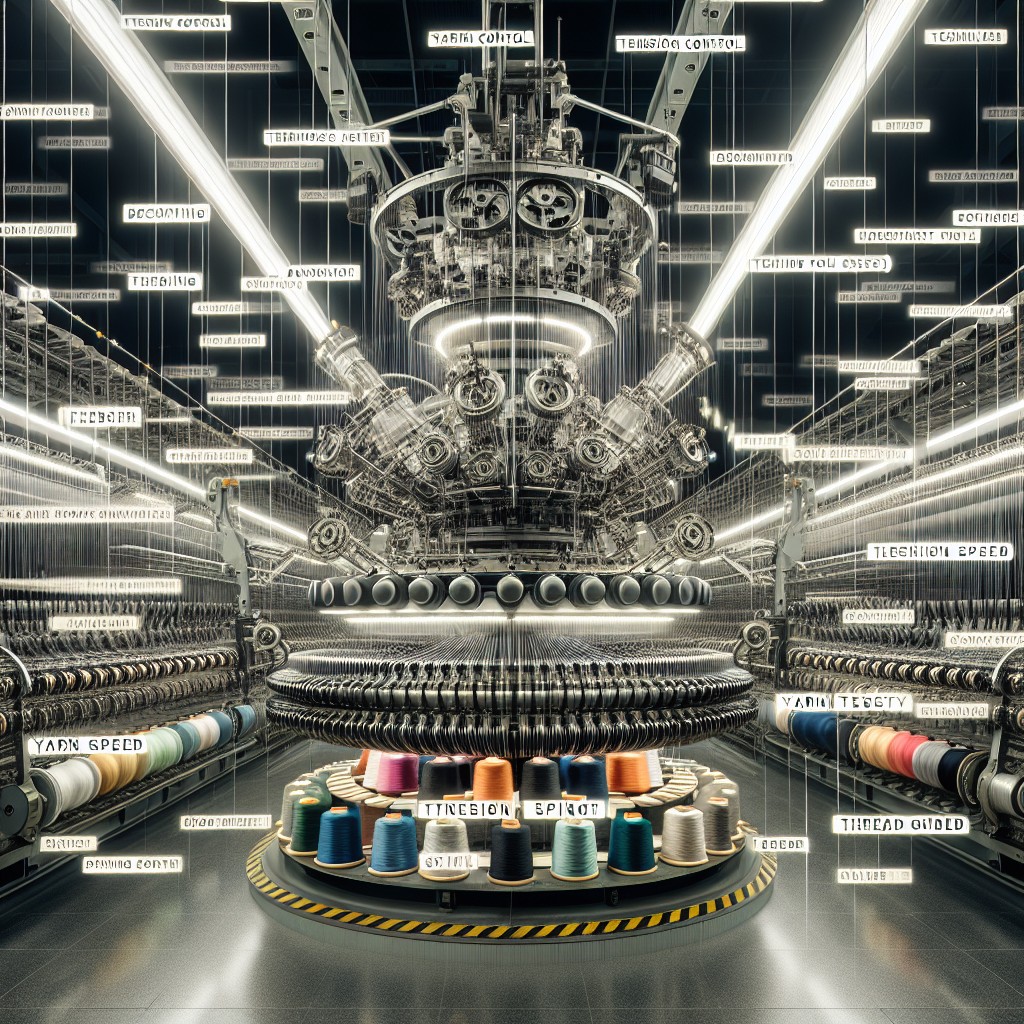Discover the various types of yarn winding machines and their unique features in this comprehensive guide, designed to help you make an informed decision for your textile needs.
Crocheting and knitting can be a relaxing and rewarding hobby, but the process of preparing the yarn can be time-consuming. That’s where yarn winding machines come in handy! These machines take on the task of winding your yarn into neat, organized balls or skeins so that you can focus on your crafting.
However, with so many types of yarn winding machines available, it can be overwhelming to choose one that suits your needs. In this article, we’ll explore the different types of yarn winding machines and their features to help you make an informed decision.
So grab a cup of tea and let’s dive into the world of yarn winding machines!
Types of Yarn Winding Machines

Yarn winding machines come in different types, each with its unique features. The most common types of yarn winding machines are precision and non-precision winders.
Non-precision winders include drum or wild winders that produce random wound packages without any specific pattern or structure. Precision winder, on the other hand, produces a well-defined package with a consistent shape and density.
Another type of precision winder is step precision or digicone/hybrid/conotronic winder that combines both the advantages of random and precise winding techniques to create an ideal package for knitting/crocheting/weaving applications.
The choice between these three techniques depends on various factors such as yarn count, fiber type (natural/synthetic), end-use application (knitting/weaving), etc., which we will discuss in detail later in this article.
Winding Machine Features

Some common features include the ability to wind both soft and hard yarns, adjustable traverse speed, programmable patterns for ribboning or picture zones on the wound package surface. Other advanced models may have additional capabilities such as automatic doffing (removing finished packages from spindles), electronic tension control systems that ensure consistent winding quality across all packages produced by a machine.
When selecting a winding machine for your textile business or personal use, it’s essential to consider which features are most important based on your specific requirements. For instance, if you’re working with delicate fibers like silk or cashmere that require gentle handling during the winding process; then you’ll need a machine capable of producing soft-wound packages without causing any damage.
On the other hand, if you’re dealing with sturdier materials like cotton or wool that can withstand more pressure during packaging; then hard-wound machines would be ideal since they produce tightly packed balls/skeins suitable for storage and transportation purposes.
What Is Soft Winding

This type of winding is ideal for delicate fibers such as silk, cashmere, or mohair. Soft wound packages have a low density and are easy to unwind without causing any damage to the yarn.
In soft winding, the traverse length is longer than in hard-wound packages. The crossing angle between layers of yarn on the package is also smaller compared to hard-wound ones.
As a result, there’s more space between each layer of yarn which makes it easier for air circulation within the package.
One disadvantage of soft wound packages can be their tendency towards deformation during handling or transportation due to their lower density compared with hard-wound ones.
When selecting your preferred type of winding machine technology (random vs precision), you should consider whether you need your final product in soft form or not since some machines may not be suitable for producing this kind of package efficiently.
What Is Hard Winding

This method of winding is commonly used for industrial purposes where the yarn needs to be transported over long distances without tangling or breaking. Hard-wound packages are also preferred when the yarn needs to be dyed as it allows for better penetration of dye into the fibers.
In hard winding, tension is applied during the process which results in tightly wound packages with minimal air entrapment between layers. The resulting package has high density and stability which makes it ideal for use in weaving machines that require constant tension on the thread.
However, there are some downsides to using hard-wound packages as well. They can cause abrasion on sensitive fibers such as silk or rayon due to their tightness and rigidity.
They may not be suitable for hand knitting projects since they do not unravel easily from center-pull balls like soft-wound skeins do.
Terminologies Related to Winding Technology

Understanding these terms will help you make an informed decision when selecting a machine for your textile needs.
One of the most important terminologies is the “winding angle,” which refers to the angle at which the yarn is wound onto a package. Another crucial term is “traverse length,” which determines how far across each layer of yarn moves on each revolution of the package.
Other essential terms include “patterning” or “ribboning” or picture zones, where specific patterns can be created in packages by controlling traverse speed and direction changes during winding. We have different types of precision winders such as non-precision/random/drum/wild winder and step precision/digicone/hybrid/conotronic winder.
Winding Angle | Crossing Angle | Coil Angle
One of these is the winding angle, also known as the crossing angle or coil angle. This refers to the degree at which a yarn is wound onto a bobbin or spool.
The winding angle can affect how tightly or loosely your yarn is wound and can impact its overall quality. A smaller winding angle will result in tighter windings while a larger one will produce looser ones.
Another important factor related to this terminology is traverse length – which determines how far across each layer of thread moves before reversing direction on the bobbin.
Understanding these terms and their implications for your specific type of project can help you choose an appropriate machine for your needs.
Winding Ratio | Traverse Ratio or Wind Per Double Traverse
This refers to how many times a thread crosses over itself during each back-and-forth movement of the machine’s arm. The number of crossings determines how tightly wound your yarn will be and can affect its appearance and performance in your project.
The wind per double traverse (WPT) is another term used for this feature, which indicates how much length is wound on a bobbin with each traversal. A higher WPT means that more yarn will be wound onto the bobbin with every pass, resulting in tighter coils.
Different types of fibers require different winding ratios for optimal results. For example, natural fibers like wool may need a lower WPT than synthetic materials like nylon or polyester.
Traverse Length
It refers to the distance that the yarn travels back and forth across the package during winding. The traverse length determines how tightly or loosely wound your yarn will be, affecting its overall quality.
If you’re working with delicate fibers like silk or cashmere, a shorter traverse length is recommended as it produces softer and more flexible packages. On the other hand, if you’re dealing with sturdier materials like cotton or wool, longer traverse lengths can create firmer packages that are easier to handle.
When choosing a winding machine based on Traverse Lengths, keep in mind that different machines offer varying ranges of options for this feature. Some may have fixed settings while others allow for adjustable lengths depending on your needs.
Understanding Traverse Lengths is crucial in determining which type of yarn winding machine suits your specific requirements best.
Patterning or Ribboning or Picture Zones
These machines can create patterns on the yarn as it is wound onto the bobbin, resulting in beautiful and intricate designs that add an extra dimension to your finished project.
The patterning process involves controlling the traverse movement of the yarn guide during winding. The traverse movement determines how much overlap there will be between each layer of yarn on the bobbin, creating different zones with varying densities and colors.
Picture zones are created by programming specific patterns into the machine’s computer system. This allows you to create custom designs such as stripes, dots, or even images like hearts or stars!
Ribboning is another type of patterning where thicker sections (or ribbons) are intentionally created along with thinner ones for aesthetic purposes.
Patterning/Ribboning/Picture Zones offer endless possibilities for creativity when using precision winding machines.
Non-Precision Winding / Random Winding / Drum Winding / Wild Winding
The yarn traverses back and forth across the package at random angles and with varying tension. This method of winding produces packages that are soft to touch but have low density.
Random winding machines are simple in design and require less maintenance than precision winders. They can handle various types of yarns such as cotton, woolen, silk etc., regardless of their count or twist level.
However, non-precision wound packages may have defects like loose ends on the surface which can cause snarls during unwinding; they may also be prone to deformation due to uneven distribution of tension across different layers.
Despite these limitations, non-precision winding remains popular for certain applications such as hand knitting because it produces soft balls/skeins that do not damage delicate fibers like mohair or angora while being used by crafters.
Precision Winding
Unlike random or non-precision winding, precision winding uses advanced technology to ensure that each package has the same density and shape. This technique is particularly useful for delicate yarns such as silk or cashmere, which require careful handling to prevent damage.
In precision winding machines, the traverse length and speed are precisely controlled to produce consistent packages with minimal variation in tension. The machine also ensures that there are no overlaps or gaps between adjacent coils on the package surface.
One advantage of precision-wound packages is their ability to unwind smoothly without tangling or knotting during knitting/crocheting/weaving processes. They also have excellent stability during transportation due to their uniformity in size and weight distribution.
However, it’s important to note that not all types of yarn require precision-winding techniques; some may be better suited for random-winding methods depending on factors like fiber content and intended use.
Step Precision/ Digicone/ Hybrid/ Conotronic Winding
These types of yarn winding machines use a computerized system to control the speed and tension during the process. The result is a high-quality wound package with consistent density throughout.
The Step Precision Winding machine uses an electronic traverse mechanism to create precise patterns on the yarn package while maintaining uniform density. This type of machine is ideal for creating patterned or ribboned packages.
Digicone Winding Machine creates cylindrical packages with soft edges by using an innovative cone-shaped bobbin design that reduces stress on the yarn during winding.
Hybrid Winding Machines combine both random and precision techniques in one machine, allowing for flexibility in production processes without sacrificing quality.
Conotronic Winders use sensors to monitor tension levels throughout the entire process, ensuring consistent results every time.
Random Winding Vs Precision Winding Vs Step-Precision Winding
Each technique has its unique features that make them suitable for different applications.
Random Winding is the simplest form of yarn-winding technology. It involves feeding the yarn onto a rotating drum in a haphazard manner without any specific pattern or tension control.
This method is ideal for low-cost production where package quality is not critical.
Precision Winding uses controlled tension and traverse speed to produce high-quality packages with consistent density throughout the length of each package. The process ensures that every layer sits tightly against each other without gaps between layers resulting in better unwound performance during knitting/weaving operations.
Step-Precision (DigiCone/Hybrid/Conotronic) Winding combines both random and precision methods by using an electronic system to adjust spindle speeds according to taper requirements while maintaining constant traverse speed across all spindles on one machine frame simultaneously producing cones with perfect shape & size consistency from start-to-finish regardless if you’re running 1 cone per spindle or 4 cones per spindle!.
Which Winding Technique Should You Select?
The type of yarn you’re using and the intended use of the finished product will play a significant role in determining which technique is best for your needs.
If you’re working with delicate or fragile fibers, soft winding may be the better option as it reduces tension on the yarn during winding. On the other hand, if you need tightly wound balls or skeins that won’t unravel easily during transport or storage, hard-winding might be more suitable.
Precision winding techniques like step-precision/digicone/hybrid/conotronic can produce high-quality packages with minimal defects and improved productivity compared to random-wound packages. However, they require specialized machinery and expertise.
Ultimately, choosing between random-winding vs precision-winding vs step-precision depends on your specific requirements such as package quality needed (soft edges), production speed required (hard edges), cost-effectiveness & machine availability.
Type of Yarn
Different types of yarn require different winding techniques and machines. For instance, delicate fibers like silk or cashmere may need soft-wound packages that prevent damage during transportation and storage.
On the other hand, sturdy fibers like cotton or wool can withstand hard-wound packages that provide more stability.
The thickness or count of your yarn also plays a crucial role in determining which type of machine you should choose. Thicker counts require larger bobbins and higher traverse speeds than thinner ones.
Therefore, before investing in a winding machine for your textile needs, ensure that you understand the characteristics of your chosen fiber material thoroughly.
Count
The count refers to the thickness or fineness of the yarn, which determines its weight and length. It’s crucial to choose a winding machine that can handle your specific type of yarn count.
For instance, if you’re working with thicker counts like bulky or super bulky, you’ll need a machine that can accommodate larger spools and bobbins. On the other hand, if you’re using finer counts like lace or fingering weight yarns, precision winding machines are ideal as they produce consistent tension throughout each strand.
Understanding your desired count is vital in choosing the right type of winding machine for your project needs.
Frequently Asked Questions
Here are some frequently asked questions to help guide your decision-making process:.
1. Are Hybrid, Digicone, Conotronic all the same?
No, they are not! While these terms refer to similar precision winding techniques that produce high-quality packages with minimal defects and excellent unwinding properties; each technique has its unique features.
2. What are the defects of soft wound packages?
Soft wound packages can have several issues such as “fluffing,” where fibers come loose from a package’s surface during handling or transport; “blocking,” which occurs when layers stick together due to moisture or pressure changes; and “collapse” when a package loses its shape due to insufficient support.
3. What are hard edges?
Hard edges occur in precision-wound yarns when there is an abrupt change in tension between adjacent layers on a cone or spool resulting in sharp angles at layer transitions.
4. How do I prevent hard edges?
To avoid hard edges while using precision-wound cones/spools for knitting/crocheting/weaving applications: use appropriate tension settings on your machine (or manual winder), select suitable traverse patterns/patterning zones based on fiber type/count/processing conditions & ensure proper packaging/storage/handling practices throughout production/distribution chain.
Are Hybrid, Digicone, Conotronic Are All the Same?
While these terms are often used interchangeably in the industry, they do refer to slightly different types of precision winding techniques.
Hybrid winding is a combination of both random and precision winding techniques. This method produces packages that have good density and shape retention while still maintaining softness.
Digicone or digital cone technology uses computer-controlled motors to wind yarn onto cones with high accuracy. The result is a package with consistent density throughout its length.
Conotronic refers specifically to machines made by Italian manufacturer Savio that use their patented “conical” technology for precise control over package formation.
While there are differences between these technologies, they all fall under the umbrella term of precision winding methods.
What Are the Defects of Soft Wound Packages?
However, they can also be prone to defects that can affect the quality of the final product. One common defect is “soft edges,” which occur when the yarn is not wound tightly enough around the package’s core.
This results in loose or uneven winding at both ends of the package, making it difficult to handle during further processing.
Another issue with soft-wound packages is “yarn migration.” This happens when individual strands within a ball or skein shift position during storage or transportation, causing tangles and knots that must be manually untangled before use.
To prevent these defects from occurring, it’s essential to choose high-quality soft-winding machines that offer precise tension control and consistent winding patterns. Proper handling techniques should be employed during storage and transportation to minimize yarn migration.
What Are Hard Edges?
This can cause damage to the fibers and make it difficult to work with. The hard edge can also create tension issues during knitting or crocheting, leading to uneven stitches or even breakage.
To prevent hard edges from forming on your packages, it’s important to adjust your winding machine’s settings properly. You should ensure that there is enough space between each layer of yarn so that they don’t compress against each other too much.
Another way to avoid hard edges is by using soft-wound packages instead of hard-wound ones. Soft-wound packages have more give than their harder counterparts, which means they’re less likely to develop tight spots in the first place.
How to Prevent Hard Edges?
These hard edges can cause problems when it comes to unwinding the yarn, leading to tangles and knots. Fortunately, there are steps you can take to prevent hard edges from forming in your wound packages.
One way to prevent hard edges is by adjusting the tension on your winding machine. If the tension is too high or too low, it can cause uneven winding and lead to hard edges.
Make sure that you have set up your machine correctly according to manufacturer instructions.
Another way of preventing this problem is by using a soft-wound package instead of a tight-wound one as they tend not only reduce edge hardness but also improve dye penetration into fibers which results in better color consistency throughout each skein or ball.
Lastly, make sure that you’re using good quality yarn for your projects as lower-quality yarns may be more prone than others towards developing these issues while being wound onto bobbins or cones due their inherent properties such as fiber length distribution etcetera.
Final Words
By understanding the different types of machines available and their unique features, you can select one that suits your needs best. Whether you opt for non-precision winding or precision winding techniques like step-precision or hybrid, it’s essential to consider factors such as yarn type, count, patterning requirements before making a decision.
Remember to pay attention to terminologies related to winding technology such as traverse length and ratio when selecting a machine. Keep an eye out for common defects like hard edges that may arise during soft wound packages’ production.
We hope this guide has been helpful in providing insights into various types of yarn-winding machines available today.
FAQ
What are the different types of winding machines?
The different types of winding machines include Cop winding machine, Pirn winding machine, Flanged bobbin winding machine, and Cheese winding machine.
How many types of cone winding machines are there?
There are four types of cone winding machines: A) Cone to cone winding machine, B) Cone to cone winded with oil, C) Hank to cone before dyeing, and D) Doubling yarn machine.
What are the main equipment used for winding?
The main equipment used for winding are winding machines or winders, which wrap materials such as string, twine, cord, thread, yarn, rope, wire, ribbon, and tape onto spools, bobbins, reels, and other similar devices.
Which is the modern winding machine?
The modern winding machine is the Auto cone, which is used to prepare a bigger package from ring bobbin.
What are the primary functions of various yarn winding machines in the textile industry?
The primary functions of various yarn winding machines in the textile industry include preparing and transferring yarn from one package type to another, removing yarn faults, and enhancing the yarn’s quality for further textile processes.
How has the evolution of winding machines impacted yarn production and quality?
The evolution of winding machines has significantly increased yarn production and enhanced quality by enabling higher efficiency, precision, and consistency in the winding process.
What factors should be considered when selecting the appropriate winding machine for a specific application?
Selecting the appropriate winding machine for a specific application should consider factors such as the type of product being wound, required precision, production speed, automation level, and budget constraints.
